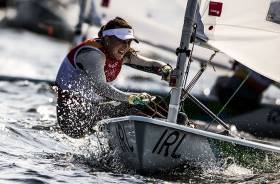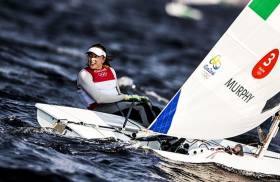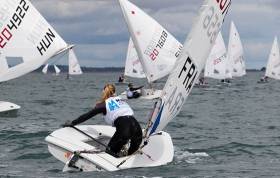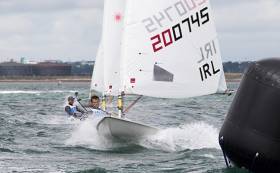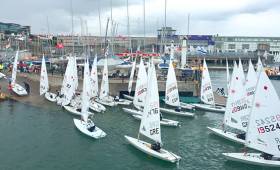Displaying items by tag: Radial
Ballyholme's Liam Glynn Lying Second at Laser Radial Youth Europeans Championships in Tallinn
Ballyholme Yacht Club's Liam Glynn is lying second overall in the boys division at the Laser Radial Youth Europeans Championships in Estonia. After four races sailed and one discard applied the former Irish Topper World Champion is a single point off the lead held by Russian Daniil Kruyskikh. Howth Yacht Club's Ewan MacMahon, the silver medal winner at the Radial World Youths in Dun Laoghaire, last month is lying 19th in the 138–boat fleet. Full boys results are here. In the girls division, MacMahon's clubmate Aoife Hopkins is fourth from 48. The girls results are here.
Report below by race organisers
The third racing day at Kalev Yacht Club was far from easy for both the sailors and organisers. Change in wind direction just after the start of the first race called for cancellation. A new start could be given after two hours of waiting only. Still, the day ended with two races under the belt and Gold and Silver fleets for boys. The leaders of the regatta are Carolina Albano from Italy and Daniil Krutskikh from Russia.
The only way to accurately determine weather and wind is by going out there. The weather forecast for today was much more modest than the reality that played out on Tallinn bay. Strong winds with gusts of 18-20 knots became fatal to several masts and caused some minor damage too. PRO Viljar Sepp commented that a long day out on the sea requires a lot of patience both from the sailors and the Race Committee team. „The course is in accordance with championship requirements, which means the duration of one race is 55-60 minutes. Competition gets tougher every day because everyone is fighting for their place both on the starting and finish lines. This causes more false starts – and today was no exception. However, today the 11:00 race had to be cancelled as wind direction changed more than 50 degrees and the course became un-sailable. We were sitting out on the sea for two hours waiting for the winds to change. But after that all went smoothly. The day is so long due to protests filed on the shore and changes that were required in the results as some guys had sailed in the wrong fleet and got worse results because of that.“
The leader Daniil Krutskikh from Russia was second in the third race (first today), but couldn’t fight higher than the 21st position in the next one due to bad positioning in the beginning. But as after the fourth race the worst result is discarded he is still in the lead with one point in front of Liam Glynn from Ireland (70-1-1-3). Yesterday’s third Daniel Whiteley from England is holding on to his position with 2-5-2-(17). Daniil Krutskikh is also leading the U-17 group. Nooa Laukkanen from Finland is second and Milo Gill-Taylor from England third.
Young Daniil Krutskikh won Laser Radial Youth World Championships only a few weeks ago and has sailed in Tallinn before. “I raced here at the 2013 Spinnaker regatta on Optimist and made it to 16th among 147 participants. I’m very grateful to my father who is also my coach who has taught me well how to manage in strong winds. I hope to do as well in the next few days”.
The best Estonian sailor is Tavo Annus from ROPK who has sailed himself to the 37th position. He is the only Estonian who made it to gold fleet.
Among girls Carolina Albano from Italy continued in her yesterday’s stride. She says stability is the key to her success. Carolina said that the winds were very changeable, like yesterday, and very strong in some moments. “Sailing was not easy today in these conditions but I managed to show stable results and now I have two first and two fourth results. Only stability helps to sail in the top of the fleet.”
Today’s first with a huge margin and third places brought Hannah Anderssohn from Germany to the second position overall. Now she has the same amount of points as yesterday’s second Louise Cervera from France (today 5-2). Aoife Hopkins from Ireland (6-4) is only two points behind them. Maris Seersant from Tallinn Yacht Club is 23rd (17-30).
From now on the boys will be racing in the gold and silver fleets. Girls will continue as one fleet.
In an unstoppable performance from Ireland's 'Breeze Queen', Annalise Murphy was again at the top of her Rio Olympic fleet at the half way stage of the Laser Radial regatta today. It puts Annalise (unofficially) third overall, just two points behind Holland and China.
In the waters of the South Atlantic Ocean, the Dubliner recorded another top five result, her third top five result of the regatta so far.
Sitting in second overall after four skilful races sailed, the Dubliner went again in the Women’s laser radial today on the outside Cocapana course with 19-21 knots from the west, ideal conditions for the Irish helmswoman.
Wearing the silver/blue jersey to denote her place overall, Annalise rounded the first mark in fifth in the 37–boat fleet, about one minute behind leader, Marit Boumeester of Holland.
The top five established a big lead and within that group Annalise moved into fourth behind leaders NED, DEN and USA. It appears that Annalise unfortunately lost out in a reaching duel with Croatian Tina Mihelic in the closing stages and finished fifth and not fourth as reported earlier.
After that, those following the race across the world on the online tracker were frustrated when technology failed!
The Radial course today was trapezoid, which included two short reaches along with windward-leeward legs. Two laps on the Windward-Leeward section were sailed.
The provisional finishing order was Marit Bouwmeester (NED) in first followed by USA, DEN, CRO, IRL, GBR, SWE and CHN.
World Sailing continues to struggle with its results system. Results by Rio organisers are here.
There's another couple of 12–knot races in prospect for Annalise Murphy in the Olympic Laser Radial class today. But after that all similarities will end for the sailors as today's races five and six are on the Copacabana course which is outside the bay and at sea. It's a crucial stage as the regatta passes the half–way stage. The race area is subject to tidal conditions and winds are expected to be different to anything seen on the first two days, perhaps a little more like Annalise's home waters of Dublin Bay?
Annalise has been training in Rio on at least ten occasions over the past four years and will be familiar with all the course locations being sailed this week.
Start time is 5:10 Irish time. No TV coverage again.
Annalise Murphy Up to Second Overall After Four Tricky Rio Races
Annalise Murphy has sailed into second overall after two more tricky Rio races today. After an opening Olympic Radial race win yesterday and a 13th scored in race two, she started today with a well earned fourth in race three and this afternoon added a seventh in race four but it might have been even better for the Dublin yachtswoman who briefly lead the final race of the day.
Annalise ascended the rankings after a good day on the innermost Ponte course in Rio's Guanabara Bay. With the discard kicking after three races, China's Lijia Xu was able to discount her disqualification in Race 1, posting the day's best score of 3, 1 to lead by five points from Murphy in second with Denmark's Anne Marie Rindom in bronze, 2 points further back.
While second overall after four races shows a very consistent performance, Annalise will rue the loss of five places in the latter half of the fourth race, slipping from 2nd to 7th at the finish.
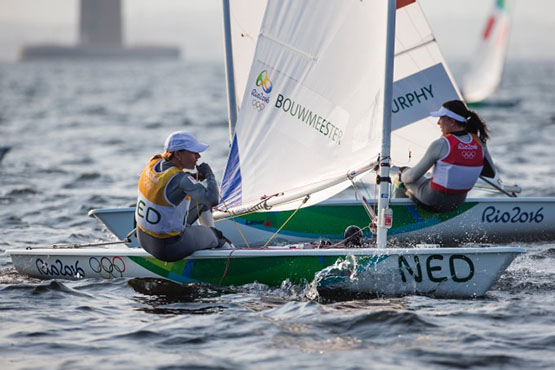 World Number one Marit Boumeester (NED) passes ahead of Ireland's Annalise Murphy in race three. Photo: Richard Langdon
World Number one Marit Boumeester (NED) passes ahead of Ireland's Annalise Murphy in race three. Photo: Richard Langdon
After some very tricky sailing over the past two days, the Irish solo sailor is coping well with Rio's notoriously fickle breezes that have so far, at least, blown into double digits for the world renowned Irish 'Breeze Queen'. There is no doubt Annalise is making the very best of the conditions that have been presented to her on the opening two days of the regatta.![]() Ireland's Annalise Murphy was challenging for the lead – and held it for a time – in Race four this afternoon as this screengrab from the live race tracker shows
Ireland's Annalise Murphy was challenging for the lead – and held it for a time – in Race four this afternoon as this screengrab from the live race tracker shows
The National Yacht Club sailor is making good on a prediction she made earlier this year where she included herself in a line up of eight of the girls who have the potential to medal in Rio.
Murphy has been in Rio at least ten times prior to the Games and only a fortnight ago won Rio de Janeiro International Sailing Week at the venue in similar conditions to today. It was obviously a pre–Olympic tonic in an otherwise fallow run of international results for the Irish sailing star.
This has been a brilliant start for Annalise and Irish sailing, especially after the disappointment of London four years ago, but there is a long way to go with six races to come over the next four days.
Annalise will be out on the Copacabana course which is outside the bay at sea. Tidal conditions and breeze will present a completely different scenario to anything on the first two days which will make for more very interesting racing.
 Laser Radial Results after four races at the Rio Olympics, showing IRL second
Laser Radial Results after four races at the Rio Olympics, showing IRL second
On the Men's course, Ireland's Finn Lynch, scored 15 and 40 to lie 24th overall. Argentina leads, with Croatia 2nd and New Zealand third.
Weather
The fresh breeze started the day in the south-south east and gradually veered to the south-south west maintaining a fairly steady pressure close to 12 knots during the race period. Tomorrow, when the Lasers race off the Copacabana beach, will see some showers, cooler temperatures and lighter winds.
Elsewhere
Britain's Nick Dempsey is dominating the RS:X men's board, posting three 1sts, a 2nd and a 4th, while in the female RS:X, Italy is one place ahead of France in RS:X women
Schedule
The Boards have a day off Wednesday, while Lasers and Radials race their fifth and sixth races. The 470s and multihulls get their regatta under way on Wednesday.
Annalise and Finn are back on the water for Race 5 at 5.15pm Irish time tomorrow before Race 6 at approximately 6.40pm. Thursday is a rest/reserve day for the two Laser events. Both the skiff events for men and women begin on Friday when all four of Ireland’s sailors are in action.
Laser Men
1. Julio Alsogaray, ARG, 7
2. Tonci Stipanovic, CRO, 13
3. Sam Meech, NZL, 14
Full results: https://www.rio2016.com/en/
Laser Radial Men
1. Lijia Xu, CHN, 7
2. Annalise Murphy, IRL, 12
3. Tuula Tenkanen, FIN, 13.3
Full results: https://www.rio2016.com/en/
Annalise Murphy Moves Up to Third, Lijia Xu DSQ From Race One
Annalise Murphy has been promoted to third overall at Rio Olympic Sailing Regatta following the disqualification of regatta leader Lijia Xu from race one of the Laser Radial Class yesterday. Murphy is now on 14 points, alongside Evi Van Acker (BEL) and Ashley Stoddart (AUS). The Irish girl is listed ahead of the others due to her win in the first race.
Xu's disqualification was for failing to get well clear of other boats in good time following a port and starboard with American sailor Paige Railey. Demonstrating that seconds are crucial, the jury noted that the Chinese sailor rounded the mark four seconds after the hail and then commenced her turns. Apparently she should have sailed to windward immediately she heard the hail and exonerated herself before the mark.
World Sailing continues to struggle with the results - twelve hours after racing ended they are still not complete.
Races 3 and 4 today for the Lasers and Radials will take place on the Ponte course, the most landward of all the courses. Today's forecast suggests southerly winds building from 11 knots at the 1300 (1700 Irish) start to 16 knots by close of play.
Rio Storm Before Olympic Sailing Starts, Moderate Winds for First Laser Races Forecast
As Irish Laser sailors Annalise Murphy and Finn Lynch, both of the National Yacht Club, prepare for their first race of the Olympic regatta later today, the Olympic sailing venue saw 40 knots of wind blast out of nowhere and hit the sailing race track from the south-west. With sand whipping across Flamengo Beach, it was an eye-watering reminder that in Rio, you really do have to be prepared for anything. An Angolan 470 ventured out for some high-wind practice, but no one else was showing much interest. With less than 24 hours before the RS:X Men and Women kick off the Olympic Sailing Competition, along with the Laser and Laser Radial, this was not the right time in the four-year cycle for putting bodies and equipment in jeopardy.
Chang Hao is representing Chinese Taipei in the RS:X Men. "My plan was to go sailing today but the wind was too strong so I am just relaxing. I'll set up my equipment and go back to the apartment and take some rest. My first Olympics was 2008, when I was 17. This is my third Olympics, so I'm getting old. But I hope I can go to five Olympics, that's my dream. This time the sailing is close to the city, which is great. I hope i can go and watch other sports, the rugby, the cycling maybe.”
Later on in the afternoon the breeze dropped away to almost nothing. The calm after the storm. The forecast for Monday and the first day of competition looks favourable, with moderate winds and sunny skies on the cards. It could be a perfect way to get things started and calm the nerves after all the tension, the hype and the build-up to this hotly anticipated contest. For local fans in Rio, they will be watching Robert Scheidt open his campaign in the Laser. Can the poster boy (aged 43) of Brazilian sailing write a new chapter in Olympic history and win a record sixth medal?
Meanwhile, there are those looking to make their first mark on the Olympics, such as Alisa Kiriliuk, helming Russia's entry in the women's 470. "This is my first time at the Games but I am not too nervous. My father, Andrei, went to three Olympic Games in the Laser, Soling and Tornado. He is helping me very much. His message to me is: Don't be afraid, just smile, relax, have fun and do what you normally do.”
Arantza and Begoña Gumucio have been sailing together for most of their lives and now the sisters are sailing for Chile in the 49erFX. "It's incredible to be at our first Olympics, and we are loving every moment,” said Arantza. Begoña chimes in, "We're staying in the Olympic Village, sharing a room and soaking up the atmosphere. And when we're out on the water, the local fisherman shout out 'Chile, Chile!' This feels like a home Games for us, we have the South American connection with our friends in Brazil, so we are going to enjoy this a lot.”
For most teams, the first race can't come soon enough. The Nacra 17 fleet, however, is one of the last to start. One team that might be happy about that is the Greek duo of Sofia Bekatorou and Michalis Pateniotis. "We have been sailing together as a team for just four months, so we are still in our honeymoon period,” said Bekatorou of her young partnership with Michalis Pateniotis. Every moment on the water counts for the Greek duo who are being coached by Anton Paz, winner of a gold medal in the Tornado catamaran for Spain, at the 2008 Games. Bekatorou won gold in the 470 at Athens 2004 and bronze in the Yngling at Beijing 2008. Pateniotis has yet to win an Olympic medal. "Working with Sofia it is easy to see how she has achieved so much in her career,” says Pateniotis. "When she sets a goal, she goes all out to get it. We would have liked more time to get ready but we have worked hard for the short time we have been sailing together. We are as ready as we are going to be now.”
Giles Scott was good enough to win a medal four years ago at London 2012. But the Briton had to bide his time as Ben Ainslie was selected for his fifth Olympic Games. Great Britain has won the gold medal in the Finn going back to Iain Percy's victory in Sydney 2000, so there is a sense of expectation around Scott, the four-time World Champion. "For me this moment has been a long time coming, a long old road. In a way it's odd to be so close to it. We've done a lot of hard work to get to this point, and now I just want it to get started. I've done as much research as I can into what to expect, talking to people who have been to the Games before. As of now, it's been how I expected, with more media interest, the measurement and so on, but it feels quite comfortable. Today we have seen a lot of wind. It's a reminder that you could easily have two weeks of no wind and you could easily have two weeks of 20 knots, so you really do have to be ready for everything.”
No matter how much people tell you to try and treat the Olympics is 'just another regatta', Annette Viborg of Denmark believes it's just not possible. Sailing with Allan Norregaard in the Nacra 17 Mixed Multihull, Viborg commented, "The Olympics is even more crazy and mad than I expected. The regulations say that you can only go training at certain times. Everything is very tensed up before the Games. But we know that it's time to bring it on. Game time.”
Reportage by Andy Rice - World Sailing
Results / Entries
A full list of sailors racing at the Rio 2016 Olympic Games is available to view here. Results will be available on World Sailing's Olympic Website when racing starts on Monday 8 August here
Live Tracking
The racing will be available to watch in 2D and 3D via the live tracking. Live tracking will be available when racing commences here
Live Tracking via the Sailviewer-3D Tablet App will be available for devices with 7" or greater screens.
Click here to download the iOS Application
Click here to download the Android Application
www.sailing.org/olympics/
Racing Abandoned, Royal St. George Will Try for Three Races on Final Day of Laser Radial Worlds
On tomorrow's final day, the KBC Laser Radial World Championship fleet will launch at 8am in an attempt to sail three more races. Dun Laoghaire's Royal St. George Yacht Club organisers are aiming for a first gun at 1000hrs, two hours ahead of schedule.
Racing on the penultimate day of the championship was abandoned today when the wind died, leaving the biggest regatta fleet in Ireland this year becalmed on Dublin Bay.
A number of races were started on both race courses but scrubbed when a fickle north–westerly breeze dropped from five knots to zero.
Since the regatta began on Monday, the boys fleet have sailed eight of a scheduled 12 races, the girls have sailed seven and the mens fleet nine.
The latest forecast is for westerly winds at 10mph at start time. No race may start after 1500hrs tomorrow.
Overall results are here
Howth Yacht Club's McMahon in Second As Laser Radial World Championships Enters Finals Stage
350 Laser Radial sailors from 48 nations got wind in their sails at the KBC World Championships off Dun Laoghaire yesterday as the massive regatta passed its half way stage.
After three days of light winds at the Royal St. George YC hosted event it was all change today when fresh westerlies blew up ideal championship conditions of 15–20 knots and over on Dublin Bay.
Only 41 points separate the top ten sailors overall as the massive 229–boat boys fleet is split into gold, silver, bronze and emerald divisions for the final two days of the regatta.
Although protests were being heard last night and results are provisional, American Henry Marshall, ninth overall at the 2015 World Championships, leads the boys after eight races by a margin of eight nett points. Keeping Irish podium hopes on Saturday very much alive are two top ten performances from Howth's Ewan McMahon in second overall on 28 points and the host club's own Conor O'Beirne (current Irish youth champion) in seventh. Third overall is Britain's Daniel Whiteley who is ten points adrift of McMahon.
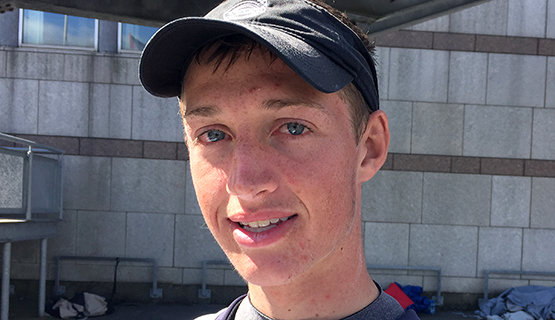 Howth Yacht Club sailor Ewan McMahon is lying second overall after eight races sailed. Photo: Afloat.ie
Howth Yacht Club sailor Ewan McMahon is lying second overall after eight races sailed. Photo: Afloat.ie
McMahon is seeking redress tonight after a double yellow flag kept him out of race six.
Five Irish boys have made it through to the gold fleet. As well as McMahon and O'Beirne, Royal Cork's Johnny Durcan (12th) and Liam Glynn (16th and Ronan Walsh (56th) are all in.
There is no doubt the regatta has so far served up conditions throughout the wind range as strong wind sailors finally got into their stride today but others had unexpectedly good results too.
Italian Paolo Giargia, who was fourth in last year's competition in Canada, said 'I'm not normally good in strong winds but today was my best day in Ireland so far, I scored a 10, 5 and 5 so I will make the gold fleet'.
 Maud Van Olst (NED 207501) approaching the gybe mark of the sixth race in the Laser Radial Youth Girls World Championships. Photo: Gareth Craig
Maud Van Olst (NED 207501) approaching the gybe mark of the sixth race in the Laser Radial Youth Girls World Championships. Photo: Gareth Craig
In the girls fleet, Norway's Caroline Rosmo took her first hit of the regatta under a black flag penalty in race six. She discards the result but still leads but only by two points from Australian Zoe Thomson on 35 points. Third is Croatia's Sandra Lulic on 66 with Dubliner Nicole Hemeryck one point back in fourth overall in the 76–boat fleet.
In the mens 42–boat fleet, after nine races sailed, Slovakia's Nik Pletikos on 44 points leads from
Poland's Marcin Rudawski on 48.0. Third is Brazil's Manzoli Lowy on 52 with Ireland's one time fleet leader Ronan Wallace fourth on 56 nett points.
Racing continues with two races tomorrow. Medium westerly winds are forecast.
Results are provisional here and subject to protest.
Wexford Boat Club's Ronan Wallace leads the KBC Mens Laser Radial World Championships at the halfway stage at Dun Laoghaire Harbour. In the boys division Howth Yacht Club's Ewan McMahon has produced a stand out performance after five races to be in third position in the biggest fleet of the competition.
In a consistent showing for the host nation entry, 27–year–old Wallace counts four top ten results on his scoresheet. He tops the international leaderboard but it couldn't be tighter as the Irish Moth sailor shares the same 36–points overall as second placed Nik Pletikos of Slovakia and Holland's Maarten Bastiaan Smit in the 42–boat fleet.
Early morning westerly breezes up to 19–knots on day three of the regatta allowed race officers to catch up on the race programme. There was praise across the dinghy park for the way the race management teams had persevered in the fickle winds since Monday.
'This is another great regatta in Dublin and I am enjoying sailing in these difficult conditions' said Croatia's Sven Stevanovic who counts a race win in his scoreline. Stevanovic is making a return trip to Dublin Bay having also competed at the Royal St. George Yacht Club when it staged the Optimist dinghy European Championships in 2014.
It was the same thumbs–up verdict from Brazil's Victor de Marchi who compared the venue to his home club, except there are 'no waves in Sao Paulo', he said.
Use of alternate marks, constant wind–moniotring and two nimble race management teams kept the championships on course again today despite the variable conditions.
It was another seven hour day on the water but it was a productive one that balanced the boys fleet races and by tea time each of the four boys fleets had sailed five qualifying races. Overall, the boys are led by American youth Henry Marshall who counts three race wins but Ireland's Ewan McMahon has four results in the top five and is discarding a seventh as the regatta enters its halfway stage for the boys divisions tomorrow. The host club's Conor O'Beirne took a race in race five yesterday afternnoon to put him in ninth place, the second Irish sailor in the top ten overall.
The girls fleet sailed three races today leaving them only two behind the full programme.
 Laser Radial Girls search for wind in Dun Laoghaire. Photo: Gareth Craig
Laser Radial Girls search for wind in Dun Laoghaire. Photo: Gareth Craig
Norway's 18–year–old Caroline Rosmo leads her 76–boat fleet with three race wins from four starts. The Oslo sailor explained her race strategy was all about staying on the high tack but she revealed a change of plan for race two when the wind swung into the east. 'For this race I decided it was the strong current [a two–knot flood tide] that was the dominant factor for me'. It is Rosmo's first time to lead at a world championships.
Top Irish girls are Dun Laoghaire's Nicole Hemeryck in 13th and Howth's Aoife Hopkins in 18th overall.
Racing continues tomorrow with a forecast for stronger winds. In a change to the sailing instructions, the race committee says it intends again to race three races back to back.
Results here are provisional and subject to protest.
Laser Radial Sailors Search for Wind at Royal St. George Youth & Men’s World Championship
Catching up on the race programme is now the priority at the KBC Laser Radial Youth and Men’s World Championship after more races were lost to fickle winds on day two of the Dublin Bay championships today.
Four races should have been completed in the 350–boat fleet at this stage but none of the boys four divisions, or the girls or men's fleets have sailed the full programme.
Of the two race courses operating, Course B's three fleets have sailed three races, Course A has sailed two and the girls fleet has only sailed one.
The boys fleet of 229 is by far the biggest and tomorrow (Wednesday) the race committee will ensure all four boys divisions have sailed the same number of races. 'It may mean starting some fleets earlier'', warned Dublin race officer Con Murphy, who officiates at the Rio Olympics next month.
Today's races were sailed again in shifting westerlies gusting up to 13–knots but the mean strength was as low as six or seven, just above the minimum permitted for racing.
It meant a long day on the water and back ashore there were some long faces at the Royal St. George Yacht Club inside Dun Laoghaire Harbour.
'That's about as tough as it gets' said Australian champion, 17–year–old, Finnian Alexander who is counting a 2, 25 and 10 so far. 'The breeze did 180 degree shifts and often the wind was 15 knots on one side of the course and five on the other'.
Alexander, from Sydney's Double Bay Sailing Club, said tactically he found it difficult to pick a side for the first windward leg and he said he was resigned to concentrating on just 'scraping through' the qualifying rounds that continue tomorrow.
Both courses were set in the north west of the bay, where evidently the best of any pressure lay. At 3pm when both green and red fleets of the boys divisions were started the breeze was as high as 13–knots from 240 degrees but within an hour it was blowing from the opposite direction.
Well done to all sailors on day 2. Hopefully better conditions for tomorrow! #KBCRadials16 #dublinbayrocksmyworld
— KBC Radial Worlds (@LaserWorlds2016) July 26, 2016
For a time it looked like the young Australian's red fleet would get a second race and a course was being set but Alexander confirmed 'the race committee made the right call to cancel it' when the breeze went east.
Italy's Ducchi Nicola, racing in the green fleet, was equally cautious about the prospect of steady winds this week. Nevertheless, the Lake Garda sailor has put together a consistent early series of a 4, 7 and ten. 'I use my head in these difficult conditions. I make sure to look all over the course before I tack', he says.
Men's fleet competitor Abdulla Janahi, the sole Bahranian sailor, was leading today's single race but the wind shifted and he dropped to fourth. He says he lost two more places on a reaching leg and admits he lost two more on the line and finished ninth in his third race of the series to put him 13th overall.
Despite being afloat for seven hours, the girls 76–boat fleet had no results after their race was abandoned. The hard working race committee did all in its power, including laying two alternate marks, to save the race from the vagaries of the wind but it was to no avail.
Sailing instructions permit more than two races per day so it is likely organisers will move to sail multiple races tomorrow but this is subject to wind. Unfortunately, winds – again from the west – are currently forecast to be less than today.
Results here are provisional and subject to protest.



























